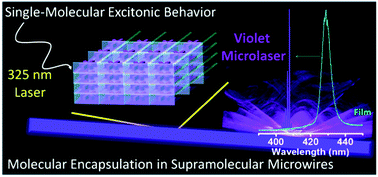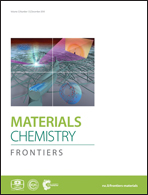Hydrogen-bonded-assisted supramolecular microwires for pure violet lasers: benefits of preventing intermolecular π–π stacking and aggregation in single crystals†
Abstract
Deep-violet lasing at the microscale is crucial for the realization of highly integrated nano-photonic and communication devices. In the work reported herein, we fabricated a type of deep-violet organic microwire laser by suppressing the intermolecular π–π stacking interaction and aggregation based on a hydrogen-bonded-assisted molecular encapsulation mechanism. Interestingly, a regular supramolecular encapsulation layer can be constructed by controlling S![[double bond, length as m-dash]](https://www.rsc.org/images/entities/char_e001.gif) O⋯H–C hydrogen-bonded superstructures in crystalline frameworks and simultaneously effectively inhibiting the intermolecular π–π stacking interactions, allowing for single-molecular excitonic behavior. For the synergistic effects of shorter effective conjugated-length and negligible intermolecular excitonic coupling, the microwire therein can act as a high-quality whispering-gallery-mode microcavity for low threshold deep-violet lasing (41 W cm−2, 6 tims lower than those of controlled materials) with an emission peak of 405 ± 2 nm, attributed to 0–1 band emission of a single molecule in diluted solution. Therefore, our work provides a proof-of-concept trial for developing a highly stable and easily processed single crystal via a molecular encapsulation strategy in a supramolecular crystalline framework.
O⋯H–C hydrogen-bonded superstructures in crystalline frameworks and simultaneously effectively inhibiting the intermolecular π–π stacking interactions, allowing for single-molecular excitonic behavior. For the synergistic effects of shorter effective conjugated-length and negligible intermolecular excitonic coupling, the microwire therein can act as a high-quality whispering-gallery-mode microcavity for low threshold deep-violet lasing (41 W cm−2, 6 tims lower than those of controlled materials) with an emission peak of 405 ± 2 nm, attributed to 0–1 band emission of a single molecule in diluted solution. Therefore, our work provides a proof-of-concept trial for developing a highly stable and easily processed single crystal via a molecular encapsulation strategy in a supramolecular crystalline framework.



 Please wait while we load your content...
Please wait while we load your content...